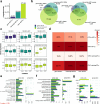Exon-variant interplay and multi-modal evidence identify endocrine dysregulation in severe psychiatric disorders impacting excitatory neurons
- PMID: 40253403
- PMCID: PMC12009313
- DOI: 10.1038/s41398-025-03366-8
Exon-variant interplay and multi-modal evidence identify endocrine dysregulation in severe psychiatric disorders impacting excitatory neurons
Abstract
Bipolar disorder (BD), major depressive disorder (MDD), and schizophrenia share genetic architecture, yet their molecular mechanisms remain elusive. Both common and rare genetic variants contribute to neural dysfunction, impacting cognition and behavior. This study investigates the molecular effects of genetic variants on human cortical single-cell types using a single-exon analysis approach. Integrating exon-level eQTLs (common variants influencing exon expression) and joint exon eQT-Scores (combining polygenic risk scores with exon-level gene expression) from a postmortem psychiatric cohort (BD = 15, MDD = 24, schizophrenia = 68, controls = 62) with schizophrenia-focused rare variant data from the SCHEMA consortium, we identified 110 core genes enriched in pathways including circadian entrainment (FDR = 0.02), cortisol synthesis and secretion (FDR = 0.026), and dopaminergic synapse (FDR = 0.038). Additional enriched pathways included hormone signaling (FDRs < 0.0298, including insulin, GnRH, aldosterone, and growth hormone pathways) and, notably, adrenergic signaling in cardiomyocytes (FDR = 0.0028). These pathways highlight shared molecular mechanisms in the three disorders. Single-nuclei RNA sequencing data from three cortical regions revealed that these core set genes are predominantly expressed in excitatory neuron layers 2-6 of the dorsolateral prefrontal cortex, linking molecular changes to cell types involved in cognitive dysfunction. Our results demonstrate the power of integrating multimodal genetic and transcriptomic data at the exon level. This approach moves beyond symptom-based diagnoses toward molecular classifications, identifying potential therapeutic targets for psychiatric disorders.
© 2025. The Author(s).
Conflict of interest statement
Competing interests: F.J.T. consults for Immunai Inc., CytoReason Ltd, Cellarity, BioTuring Inc., and Genbio.AI Inc., and has an ownership interest in Dermagnostix GmbH and Cellarity. The other authors declare no competing interests. Ethics approval and consent to participate: All methods were performed in accordance with relevant guidelines and regulations. For Dataset 1, postmortem brains were collected with approval from the Ethics Committee of the Victorian Institute of Forensic Medicine, 1 and this study was further approved by the Human Ethics Committee of Melbourne Health [23]. For Dataset 2a, ethical approval was obtained from the Human Research Ethics Committees at the University of Wollongong (HE2018/351) and the Ludwig-Maximilians-Universität Munich (17-085 and 18-393). Two publicly available datasets (Dataset 2b and 2c) were used, and ethical approval for these studies was obtained by the original data generators. For Dataset 1, written informed consent was obtained from the next of kin for all tissue donations. For Dataset 2a, all donors provided written informed consent for brain donation prior to their death, which was subsequently confirmed by their next of kin.
Figures





References
-
- Binder EB. Polygenic risk scores in schizophrenia: ready for the real world? Am J Psychiatry. 2019;176:783–4. - PubMed
MeSH terms
Grants and funding
- 28063/Brain and Behavior Research Foundation (Brain & Behavior Research Foundation)
- 26486/Brain and Behavior Research Foundation (Brain & Behavior Research Foundation)
- #26486/Brain and Behavior Research Foundation (Brain & Behavior Research Foundation)
- 566967/Department of Health | National Health and Medical Research Council (NHMRC)
- PG2020645/Rebecca L. Cooper Medical Research Foundation
LinkOut - more resources
Full Text Sources
Medical

